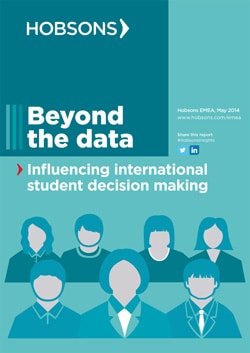New survey highlights international students’ top priorities when considering where to study abroad
recently released a new report called Beyond the data: Influencing international student decision making. The report is based on Hobsons’ International Student Survey and provides important insights into how international students decide where they will go for study abroad.

- International students’ perceptions and expectations;
- The difference between what these students say and actually do;
- The heterogeneity of target audiences (there are international student profiles, plural);
- The value international students put on teaching quality as well as what this term (which can be vague) means to them.
On the all-important question of the factors that motivate student decision-making with respect to selecting an institution, the report finds:
“The five most important factors for international students when considering study abroad are consistent regardless of where they intend to study. These five factors in order of importance are: quality of education (compared to their home country), international recognition of qualifications, the country’s attitude to international students, safety, and ease of getting a visa. The four least important factors for international students when considering study abroad are also consistent regardless of where they intend to study. The four least important factors are: distance from home country, ability to get permanent residency in the destination country after study, exposure to culture or life in the destination country, better job prospects in the destination country.”Beyond the data
builds on these initial findings to offer a ten-point plan to help institutions make smart decisions about their recruiting and communications practices with international students. In this article, we sum up the top ten strategic implications from the survey and offer a commentary on each. 1. International students consider course first, country second, and institution third. Not only does this highlight the importance of emphasising a country’s benefits and attractions in institutional marketing, it underlines how critical it is to ensure key course offerings are front and centre in all marketing materials. Particularly in online channels, this is often the primary information that students are searching for – more than institutional brands and more than information on specific locations – and it is crucial that your programme information is easily found by both prospective students and search engines. For additional background, please see our earlier post on international students’ web search activity and how this can inform your Search Engine Optimisation (SEO) strategies. 2. Fees are the second-most important consideration for international students and the number one reason for declining offers. With the competition for international students fiercer than ever, and at a time when more low-cost alternatives are entering the market, carefully researching and setting fee structures has never been more urgent. This isn’t to say that fees should be unreasonably, unsustainably low, but it is to say that institutions with higher-than-average fees should be very clear on why this is and the benefit it offers students. Both lower-than-average fees and higher-than-average fees can be basis for competitive advantage or differentiation, but only if the benefits for prospective students are well presented. Please see our earlier posts on price sensitivity and pricing strategy for more on this key pillar of your marketing plan. 3. International students place a higher value on course/subject rankings than on institutional ones. As Hobsons says, “institutions should lead marketing campaigns with their top-performing courses, paying specific attention to subjects or courses in which the institution ranks particularly well. Do not underestimate the power of the “halo” effect.” 4. Perception of student satisfaction does not drive choice of institution. This is an interesting finding, and it gets at the heart of what most students are looking for: well-respected programmes that act as a springboard to their success. Perhaps students assume that they will be satisfied studying at institutions and programmes with good reputations – and so aren't looking for this metric. In any case, the Hobsons research suggests that student satisfaction is not the element to lead with in marketing campaigns. 5. Graduate outcomes are a key factor in international students’ decision-making. This is a perfect contrast to finding #4, in the sense that it shows how objectively prospective international students think about their choice of study. Their decision-making is long-term in orientation. They are pursuing a degree not only for the sake of an education, but also for the sake of the rest of their lives. Show how your programmes are benefitting your graduates. 6. Each institution has a role to play in marketing their country as a desirable destination. We couldn’t agree more with Hobsons that “clearly articulating the benefits of studying in the UK [or whatever destination country the institution finds its home], followed by location and the specific institution, will ensure that a complete lifestyle picture is being painted.” 7. Country-level messaging reinforcing welcome and safety of international students will support institutional marketing. Harking back to finding #1, which showed that students consider country before institution, #7 is extremely important. Even the best institutional marketing cannot compete with unwelcoming immigration policies, visa hassles, impediments to international students being able to work, or most crucially, incidents of crime against international students and racial intolerance. Conversely, country-level efforts to attract international students (see a recent article on New Zealand’s work here) benefit all of the country’s institutions that choose to leverage them. 8. Institutions must be clear on their brand value proposition for each course. Given students’ prioritisation of course in their decision-making, it is essential that institutions align the way they communicate their courses with the way they communicate their brands – and also that they ensure courses are living up to the overall promises of the institutional brand. 9. Students want to engage with institutions and their content through visual social media sites (YouTube and Instagram) during the research phases of selecting an institution. Not surprisingly, the old adage, “seeing is believing” applies here. For video tips, please see our articles here and here, and for photos, see here. 10. It’s not just about giving out information or an offer: students need to be nurtured from the information-gathering stage through to enquiry and then application. Yes! And extra points for using “nurture” – it’s perfect. The Hobsons report does a great job of underlining that nurturing becomes a lot easier if institutions “invest the time at the outset to obtain key information about their prospective students and their expectations, enabling them to target their marketing by profile.” If you don’t know much about the different profiles of students in your target market, it is very hard to do anything more than “push” information out there without really engaging with individual students and their needs. This article provides a good foundation for how institutions are using data and data analysis to help understand student profiles better for more informed international student recruitment. Other key findings of the report include:
- “Electronic content is vital. An institution’s website is important to more than 70% of respondents, and the online/electronic university prospectus is important to more than 50%...An institution’s website is the key source for international students to gather information. Institutions need to ensure that all roads lead to enquiries and there are enough signposts to lead international students there.”
- “Students expect quick responses when seeking information from an institution. Around three-quarters (74%) of respondents want a detailed reply by email within three days, and 71% expect a short reply (possibly automated) within 24 hours.”
- “Social media is primarily used in the research and information gathering phase, but relevance of this media declines as the lifecycle matures.”
Many of these observations are not unique to Beyond the data, but there is always value in data-based findings that reinforce important aspects of marketing strategy and positioning and we certainly recommend the complete report, and its many detailed observations from the student survey, for closer reading.
Most Recent
-
ICEF Podcast: Together for transparency – Building global standards for ethical international student recruitment Read More
-
New analysis sounds a note of caution for UK immigration reforms Read More
-
The number of students in higher education abroad has more than tripled since the turn of the century Read More
















